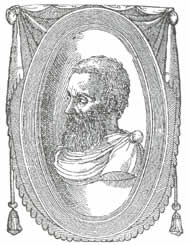Giovanni Francesco Straparola facts for kids
Giovanni Francesco Straparola (born around 1485, died 1558) was an Italian writer. He wrote poems and collected short stories. He moved from Caravaggio to Venice. In Venice, he published a famous collection of stories called The Facetious Nights or The Pleasant Nights. This book is important because it has some of the first printed fairy tales in Europe. These are the fairy tales we know today.
Contents
About Straparola
His Life
We don't know much about Straparola's early life. He was probably born around 1485 in Caravaggio, Italy. This town is near Milan. The first time we hear about him is in 1508. He was in Venice and signed his name "Zoan" on a book he published. This book was called New Works.
In 1550, he got permission to publish The Pleasant Nights. He was said to have died in 1558. However, some people think he might have died earlier. This is because his picture and a special phrase stopped appearing in his books after 1556 or 1557. Since he was a learned man, he might have been a teacher or a writer for someone important.
His Name
"Straparola" was probably not his real last name. It's thought to be a nickname. The name comes from an Italian word meaning "to talk too much" or "to talk nonsense". Using a nickname was smart back then. Publishing funny or critical writings in Venice could be risky for writers.
His Writings
New Works
In 1508, Straparola published his book Opera nova (New Works) in Venice. This book had different kinds of poems. It included sonnets and satirical verses, which are poems that make fun of things. The book was printed again in 1515.
The Facetious Nights
Straparola published the first part of The Pleasant Nights in 1551 in Venice. The second part came out in 1553. This is his most famous work.
The Pleasant Nights has 75 short stories, fables, and fairy tales. The stories are grouped into "Nights" instead of chapters. The book is set up like a party. Italian noblemen and women gather to sing, dance, and tell stories. The Pleasant Nights also includes riddles. This style is similar to Boccaccio's famous book, Decameron.
One story in the second book was removed later. This was because of the Church's influence. Also, the whole collection was put on lists of "prohibited books" between 1580 and 1624. This meant people were not allowed to read them.
Many people believe Straparola took some of his stories from older works. He even wrote in his book that the stories were "not mine." He said he "feloniously taken" them from others. He claimed he only wrote down what he heard from the people telling the stories. This was a common way for writers to avoid trouble. They could say they were just recording what others said.
Fairy Tales
Straparola's Pleasant Nights is the first known book to print fairy tales as we know them today. Here are some of the fairy tales found in his collection:
- "Cassandrino" ("The Master Thief")
- "Pre Scarpafico" ("The Priest Scarpafico")
- "Tebaldo" ("Doralice")
- "Galeotto" ("The Pig King" or "Prince Pig")
- "Pietro" ("Peter the Fool")
- "Biancabella" ("Biancabella and the Snake")
- "Fortunio" ("Fortunio and the Siren")
- "Ricardo" ("Costanza/Costanzo")
- "Aciolotto" ("Ancilotto, King of Provino")
- "Guerrino" ("Guerrino and the Savage Man")
- "I tre fratelli" ("The Three Brothers")
- "Maestro Lattantio" ("The Tailor's Apprentice" or "Maestro Lattantio and His Apprentice Dionigi")
- "Cesarino" ("Cesarino the Dragon Slayer")
- "Soriana" ("Costantino Fortunato")
The "Rise Tale" Idea
Some people think Straparola might have created a type of fairy tale plot called the "rise plot." In these stories, a poor person, like a boy or girl, uses magic to get married to someone rich. This leads them to become wealthy. It's like a "rags-to-riches" story using magic.
Examples of "rise tales" in Straparola's work include:
- "Peter the Fool": A talking fish helps a town fool become a king.
- "Fortunio and the Siren": An orphaned boy gets magic powers from animals and marries royalty.
- "Adamantina and the Doll": A magic doll helps two women marry into royal families.
- "Costantino Fortunato": A talking cat helps its owner gain a royal marriage and wealth.
Influence on Other Writers
Many later fairy tale writers were inspired by Straparola. For example, Mme. de Murat, a French fairy tale writer, said in 1699 that everyone was taking stories from "Straparola."
You can see parts of Straparola's stories in the works of other famous authors:
- Giambattista Basile's "Peruonto" and Mme d’Aulnoy's "The Dolphin" are similar to Straparola's "Peter the Fool." In these stories, a foolish person helps a magical fish or dolphin. The magical creature then grants wishes.
- Basile's "Cagliuso" and Charles Perrault's "The Master Cat, or Puss in Boots" are like Straparola's "Costantino Fortunato." They all feature a talking cat that helps its owner marry into a royal family and become rich.
- "Iron Hans" in the Brothers Grimm's collection is similar to Straparola's "Guerrino and the Savage Man." In both, a hero is helped by a wild man he sets free.
- Joseph Jacobs's "The Dancing Water, the Singing Apple, and the Speaking Bird" is much like Straparola's "Ancilotto." In these tales, children are sent on difficult quests to stop a king from seeing them.
- Jacobs's "The Master Thief" is similar to Straparola's "Cassandrino the Thief." A judge or lord challenges a thief to prove his skills, or he will be killed.
- Basile's "The Goose" is like Straparola's "Adamantina and the Doll." A magical doll or goose helps two poor sisters become rich and marry into royalty.
Italo Calvino was also inspired by Straparola when he put together his book Fiabe italiane.
Works by Straparola
- New Works (1508)
- The Pleasant Nights volume 1 (1551) and volume 2 (1553)
See also
 In Spanish: Giovanni Francesco Straparola para niños
In Spanish: Giovanni Francesco Straparola para niños


